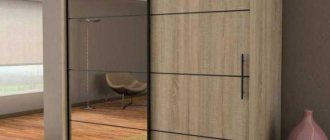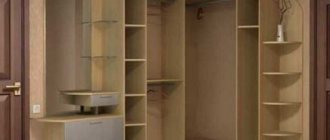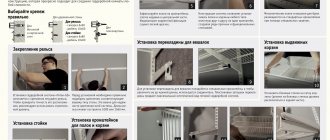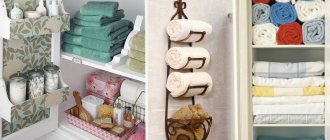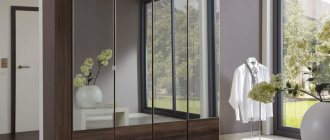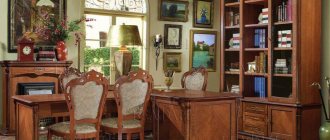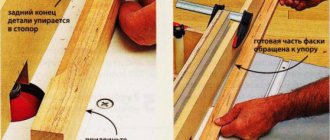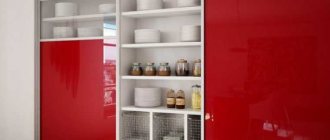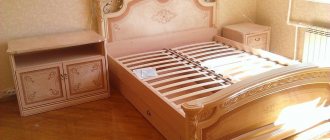You can assemble Basya's wardrobe yourself. You will have new experience, while you will save money and raise your authority in front of your family.
The Basya wardrobe is suitable for a hallway or bedroom. Thanks to its small dimensions, it is spacious, but the main advantage for small apartments is the sliding doors. This article will not talk about its advantages, but about how to properly assemble a cabinet.
Make room on the floor for ease of use during assembly. There are times when this is not possible, then find an assistant and assemble the wardrobe while standing. Understand the instructions, lay out all the components and arrange the racks, shelves, and other components in order.
The internal parts of the external racks have many holes for shelves and other elements. In order not to confuse them during assembly, marks can be placed on the sides - left and right sides.
To assemble Basya you will need:
- hammer,
- rubber mallet,
- roulette,
- metal square,
- screwdriver,
- screwdriver,
- 4 mm hex key.
Assembly order
The base (bottom sheet of laminated chipboard) is screwed with euroscrews (confirmats) to two longitudinal legs made of laminated chipboard. The supporting part must have an edge so that the material does not swell from moisture while standing on the floor. You can immediately nail the thrust bearings - 3 pieces per strip.
The work takes place on the floor and therefore the box is assembled face down
.
You need to attach the middle post to the base of the Basya cabinet and then the side ones, and in order not to return to the bottom again, put plugs in the holes of the Euroscrews. Don't forget to install heel supports on the side racks of the cabinet.
The next step is to tighten the top lid of the cabinet and install the plugs. To give rigidity to the box, install shelves that are tightened with Euroscrews between the sections (in some configurations such shelves are not available).
We measure the diagonal and nail the back wall
Before nailing the back wall, make sure that the wardrobe is rectangular in shape. This is done with a square, placing it on the corner of the cabinet, or using a tape measure to measure the diagonals. You can use two options at once to make it more accurate. All angles should be equal to 90º, and the diagonal of the two sides should be the same. In case of unevenness, it is necessary to level the housing by moving it to a smaller direction.
If the box has the exact shape and details, then you can nail the back wall of the cabinet. The reinforcement wall is attached not only around the perimeter, but also to the shelves.
Now the structure should be rigid and can be installed in a vertical position.
Installation and configuration of doors
Two running rollers are screwed to the top of each door. It happens that mirrors come attached to the middle door of Basya's closet, but if the manufacturer did not glue it, then you will have to do it. To do this, you need to attach a mirror and outline it in a circle. Then plant it on liquid nails.
Now you need to install the lower guides and upper rails for the rollers. Stepping back 2 cm from the edge, screw the guide at the bottom and the rail at the top in the same way.
Then carefully insert the doors into the grooves of the profile. The motion of the rollers should be soft, and the doors should fit well and not touch or cling to anything. In case of poor running, the rollers can be adjusted. After this, screw the rollers with a fixing screw. We screw the guides onto the lower parts of the doors. Now we install the top front strip and install shelves and a rod for dresses. The Basya cabinet is ready for use.
Assembly instructions
In order to start assembling according to the diagram, you must first unpack all the parts. One box contains doors, another contains walls, and the third contains a mirror.
Assembling a wardrobe involves the step-by-step implementation of the following steps:
- First of all, we unpack the box with the walls and begin to assemble the frame, arranging the parts so that the assembled structure is face down.
- To fasten the parts to each other, you need to use special screws - confirmats or, as they are also called, Euroscrews. This fastening element does not destroy the material and is able to withstand pull-out and bending loads.
- We begin mounting from the bottom corner, attaching the side wall to the bottom part.
- We install a parallel wall and a stand dividing the frame into two halves.
- We fasten the side wall with the stand-up shelf located in the center. This is necessary for a more rigid attachment.
- To complete the installation, screw the cabinet lid, but not all the way.
- Using a tape measure, we measure first one and then the second diagonal. When fastened correctly, they should be equal. If there is a difference between them, then it is necessary to align the frame by shifting it to a smaller side. The structure is considered correctly fastened if each of the four corners is 90 degrees, and both diagonals are of equal value.
- Now you can begin attaching the back wall, which consists of three parts. Each part is fixed with nails nailed at a distance of 10-15 cm into the ends of all elements. We start from the side on which the shelf is located. Having laid and leveled the sheet, we draw a segment that determines the level of the previously fixed shelf. This must be done in order to nail the back wall not only to the ends of the structure, but also exactly to the shelf. After all the parts are nailed, you need to fasten them with special profiles.
- We proceed to the doors - we screw the running roller to each from the top on both sides.
- Then we begin to work on the middle door, on which we will attach the mirror. We place it on the surface face up and apply a mirror to it, which we trace, having previously placed it evenly. We degrease the prepared surface, and remove the protective films of double-sided tape from the inside of the mirror. In order for the mirror to stick evenly, you need to lay linings between the mirror and the door; their thickness should be greater than the tape. Then we begin to carefully remove them.
- Now we install the shelves in the linen compartment from top to bottom, and then attach the dress rod. We screw in the upper rails and lower guides, having previously drilled holes in them. We start with the bottom guide, stepping back from the edge about 2 cm, and finish with the top.
- Carefully install the doors into the grooves of the profiles. We check the movement of the doors: it should be smooth and without unnecessary sounds, and the doors should fit tightly. If necessary, we make adjustments by tightening the running roller. Next, tighten the fixing screws and install the lower guides on each door. After that, we hang the doors and fix the top bar with self-tapping screws.
More detailed instructions for assembling the Basya wardrobe can be viewed in the following video:
Download a video and cut an mp3 - we make it easy!
Our website is a great tool for entertainment and relaxation! You can always view and download online videos, funny videos, hidden camera videos, feature films, documentaries, amateur and home videos, music videos, videos about football, sports, accidents and disasters, humor, music, cartoons, anime, TV series and many other videos are completely free and without registration. Convert this video to mp3 and other formats: mp3, aac, m4a, ogg, wma, mp4, 3gp, avi, flv, mpg and wmv. Online Radio is a selection of radio stations by country, style and quality. Online Jokes are popular jokes to choose from by style. Cutting mp3 into ringtones online. Video converter to mp3 and other formats. Online Television - these are popular TV channels to choose from. TV channels are broadcast absolutely free in real time - broadcast online.
If you, having bought a wardrobe,
decided to save money on furniture assemblers, then this article with detailed instructions and some secrets will help you assemble a cabinet without the mistakes that beginners usually make.
We hope that this article will save you not only time on assembly and disassembly, but also your expensive nerves. Sliding wardrobes have different designs, and the way they are assembled
may vary slightly.
We offer you the most common and common wardrobe, the assembly instructions
for which will also help during the assembly of other models.
Tool for assembling a wardrobe
To assemble a wardrobe, you need a screwdriver, a screwdriver, a set of hex keys, a tape measure, and a utility knife. Sliding wardrobe with three doors with pull-out shelves and a hanger rod
Assembling the base of the wardrobe
There are two types of sliding wardrobes, in some the base is screwed to the body separately, in others the side walls are the basis of the base and are connected by a longitudinal plank-base.
This cabinet has a separate base, which is assembled using Minifixes
(furniture corners).
The indentation should be the same on all sides. Make sure the angles are 90 degrees. Typically, furniture makers use self-tapping screws measuring 4*16. Sometimes the base can be screwed a little closer to the front side if you have a wide baseboard in the room. We nail the support legs onto the base. Sometimes the manufacturer equips the cabinet with adjustable legs, with the help of which the level of the cabinet is adjusted. For convenience, cabinets are assembled mainly in a lying position, so it is recommended to provide sufficient space for installation of the cabinet in advance.
Assembling the cabinet body
Follow the included instructions carefully. All parts and fasteners have their own designation. It is very important not to confuse the body parts, which at first glance are the same and may differ in only two or three holes. Otherwise, when the cabinet is almost assembled, you will have to disassemble it again and put the parts in their place. Lay the side wall pieces parallel. Important! Be careful not to confuse the top and bottom of the parts, as well as the front side with the back
.
The front side always has an edge, the back side may have a groove for the back wall made of fiberboard. This cabinet is also assembled using Rafix
. A part that is similar to a minifix, but has a plastic body. We screw the rods from the rafixes into the holes intended for them and tighten them with an eccentric.
Be careful that until the cabinet body is assembled and the back wall is installed, all fasteners can be easily broken. Do not warp the cabinet parts, keep the corners straight. Installing the back wall of the cabinet. After the cabinet body is assembled and the connections are tightened, you need to turn the cabinet over and place it face down. To avoid scratching the front of the cabinet, it is advisable to place cardboard or a rag. You can use cabinet packaging.
Cabinet diagonal
Before attaching the cabinet wall, you need to set the diagonal so that all corners of the cabinet are 90 degrees. To do this, you need to use a tape measure to measure two diagonals of the cabinet. They must be equal in length (See diagram). Some cabinets do not have a groove for the back wall and simply nail it to the end. It is better to use self-tapping screws or a stapler with long hardened staples. Since the wall usually consists of two or more parts, a connecting strip is provided at the junction points. If there is none, then it is better to fasten it to the internal parts with a stapler, since the thickness of the chipboard body is 16 or 18 mm, when you screw two pieces of fiberboard to it, you only have 9 mm left. stock. It’s easy to miss with a self-tapping screw and go past the end of the part where the back wall is connected and screwed. Now the cabinet can be installed. It is better to lift with an assistant. It's easier and safer that way. Once the cabinet is in place, you can install the shelves. For this purpose, either shelf holders, or corners, or rafixes are provided. We screw the rods of the rafixes into the sockets under them and lower the shelf on top of them. It is easier to start installation from the upper shelves. We screw the roller guides. The screws should not protrude so as not to interfere with the movement of the rollers. Insert the assembled drawers into the guides. They should slide out easily without rubbing. We screw the flanges for the rod. There are usually markings for self-tapping screws. If not, then you need to retreat 7-10 cm from above, enough to be able to hang hangers.
How to mount
The easiest way to deal with all the complexities of installing a Basya wardrobe is to entrust this process to professionals. But, if you don’t want to spend extra money, or are simply used to doing everything yourself, then you can try to assemble your furniture yourself.
This process begins with the installation of the frame. All design details are marked with a special number, which is also indicated on the drawing. Assembling the wardrobe body begins from the bottom corner. To do this, one of the side walls is attached to the bottom. A parallel wall is installed nearby. The installation is completed by fastening the roof.
When the frame is ready, you can nail the back wall to the base. Chipboard sheets are attached using self-tapping screws. They begin to be fixed from above and fall down. The back wall must be secured both from the outside and from the inside. After completing this process, it is advisable to check whether all parts are securely fastened - an installation error can significantly reduce the life of the cabinet.
Having secured the main parts, you can fix individual shelves inside the cabinet. To secure the five shelves, you will need self-tapping screws, wooden dowels, glue and a drill. The main tip to remember when installing shelves is to start at the top and work your way down. When installing shelves, pay attention to the fact that their front edge is in front, and not rough, raw edges.
The most difficult step is installing the door. The sliding wardrobe door mechanism must be installed so that the door opens and closes well. How convenient it will be for you to use the wardrobe depends on how correctly the mechanism is installed. All rollers and fixing elements are included with the main parts. Additionally, there is also a mirror for the facade on a film basis. Finally, after all these procedures, close all visible holes with the decorative plugs included in the kit and check the quality of the assembly.
Self-assembly of furniture helps to significantly save money. It’s good if a person has simple skills in assembling objects. It will be useful for beginners to learn how to assemble a wardrobe themselves. Step-by-step installation steps for each element of the product will allow for quick installation.
Among all types of clothing storage products, the leading place today is occupied by the wardrobe. It is multifunctional, spacious, comes in different shapes and sizes, and does not require additional space to open the doors. That is why most people, when choosing between a wardrobe and a sliding wardrobe, prefer the latter option.
Assembling a sliding wardrobe with your own hands in the video presented is not at all difficult - all you need to do is have the necessary tools in your apartment and be familiar with the design of the product. Often, when ordering a cabinet without the services of assemblers, the company sends a document that contains a drawing of the product. This also lists all the component parts, which are numbered in order. By looking at the drawing and comparing the elements of the cabinet, you can intuitively assemble the product.
To work according to the sliding wardrobe assembly diagram, you will need the following tools:
- building level - to check the levelness of the installation parallel to the floor;
- corner;
- rubber and regular hammer;
- straight and Phillips screwdriver;
- roulette;
- pencil and ruler;
- screwdriver;
- wood drill - to make holes;
- metal drill – for installing an aluminum base.
Additional tools for assembling furniture yourself include a jigsaw, drill and sandpaper. It is also necessary to prepare all the details of the cabinet, which means checking the diagram to ensure that the number of items matches. Pay attention to the fittings and mechanisms: if there are drawers in the closet, ball guides should be included.
Doors for the product are often supplied ready-made. They are pre-installed with rollers and a strip of soft material. The door must be installed in the final phase.
Tools
Installation of wardrobe doors
Now that the cabinet is almost assembled, all that remains is to install the doors. It is advisable to first adjust the level of the cabinet. Otherwise, the doors will not close tightly. To install the top guide, you need to drill at least 5 holes for self-tapping screws, two on each side and one in the middle. The guide should be level with the edge of the cabinet lid. To install the lower guide, you also need to drill three holes with a diameter of 4 mm, and chamfer it with a drill of a larger diameter so that the screw head is flush with the guide. Sliding wardrobe guides from different manufacturers require different cabinet edge offsets. To simplify installation, you can simply place the guide on the installation site, and fix it when the doors are installed. Installing the door into the guides. First, the upper rollers are inserted into the upper guide and raised all the way, then the lower rollers are inserted. First, the two side doors are inserted into the second track, then the middle door into the first track. The doors are adjusted with a hex wrench (sometimes with a cross screwdriver). When the level is set correctly, the door should fit snugly against both walls of the cabinet. Now you can glue the sealing brushes. First, the protective film is removed. Attention, after removing the protective film, it is not recommended to touch the place where the brush will be glued with your hands. Greasy fingerprints will make the brushes less durable.
A sliding wardrobe is one of the most convenient and compact ways to store things. It has small shelves for light items of clothing, and large ones for bulkier items, there are compartments for storing skis, a compartment equipped with a rod for placing outerwear, etc.
The compactness of the closet is made possible by sliding doors, which do not require space to swing open; they move on special rollers located inside the structure of the door itself. Even a person inexperienced in such matters can assemble such a cabinet, since the assembly principle is quite simple and does not require the use of special tools.
VIDEO: DIY wardrobe. How to assemble a wardrobe?
Lately, sliding wardrobes have become increasingly popular. They are compact and convenient for storing all your daily necessities. The sliding door hides not only clothes, but also shoes, accessories and even necessary household appliances. This allows you to save a lot of space in your room by rationally using every centimeter of your room.
A sliding wardrobe can be installed not only in the bedroom, but also in the living room or hallway. It does not take up much space, so it will fit even in a small apartment. All these characteristics are relevant for a simple and inexpensive Basya wardrobe, which will be discussed in this article.
We install the side racks and the top cover
Now the final part of assembling the frame is the installation of the side posts and the top cover. All three elements must be installed simultaneously.
Although this action depends on the design features and location of the fastening points on these parts. First, we install the sidewalls, fastening them at the bottom with the base with confirmations.
Then we put the lid on top, align the holes in all the parts and also tighten the fasteners. Here you need to leave a little free play, since you will need to level the entire frame.
We nail chipboard sheets
The next assembly step is to nail the fiberboard sheets to the back of the cabinet.
These sheets will not only serve as a back wall, but will also reliably keep the structure from loosening throughout the entire period of operation.
As a rule, the canvases have a decorative treatment on the front side in the form of a laminated colored surface. The sheets are fastened using small nails, which must be driven into the ends of all cabinet elements (racks, partitions, shelves).
Here it is important to guess the place of nailing, because the cabinet parts are not visible from the back side, and damage resulting from the wrong choice negatively affects the appearance of the product.
We place the rails - guides
Now the most crucial moment is the installation of the lower and upper rails for the doors. The bottom rail has two grooves for the movement of rollers:
And the top is divided into two sections:
In both, you must first drill holes for screws to attach them to the base and cover.
The holes must be chamfered to allow the screw to be screwed in flush.
It is enough to make 4 holes in each plank. We fasten the bottom rail first, marking the corresponding fastening points.
The distance from the edge of the base to the leading edge of the rail should be 2.5 cm.
To ensure that the doors do not jam and they move evenly, it is necessary to install the cabinet strictly horizontally, which can be done using a regular building level.
The longer the level, the more accurate the horizontal indicators will be.
The top rail is attached in a similar way with the only difference being that you need to drill holes in a checkerboard pattern in both compartments.
Screws from the set supplied with the cabinet are used as fasteners.
From the front end of the top cover to the beginning of the edge of the rail, the distance should be 2 mm.
We hang the doors
Before this stage, you need to check the gutters in the lower bar for the absence of debris that will interfere with the movement of the rollers, once again make sure that the planes are horizontal and check all connections for rigidity.
The door is first inserted into the top rail.
And then the end rollers need to be placed in the groove of the lower rail.
All 4 doors are installed in this way (the main thing is not to confuse the picture).
In principle, there is nothing complicated in installing a wardrobe. You just need to take a responsible approach to all stages of its assembly, and then you will not only improve your skills as a home craftsman, but also probably be grateful for preserving the family budget.
Characteristics and Features
This cabinet is perfect for those who are slightly on a budget and looking for an inexpensive cabinet in a compact size. This model costs two or even three times less than its analogues, but at the same time it looks just as good and serves no less. It is available in several basic colors, so you can choose a cabinet that will fit perfectly into any interior you choose. The closet is spacious enough, so you can fold and hang in it not only things from your basic wardrobe, but also things that you don’t currently wear or use.
The only drawback that almost all buyers note is the difficulty in assembling it. Or rather, the lack of simple and understandable instructions that explain in detail how and in what sequence you need to assemble Basya’s wardrobe.
Assembly is complete - the result is in the photo
Every apartment must have such a multifunctional piece of furniture as a wardrobe. It will save space in your home and organize space. Not everyone can afford to purchase it due to various circumstances. This is not a reason to refuse such a thing. For a jack of all trades, it won’t be too difficult to make and assemble it yourself.
Of course, some knowledge will be required. There is nothing complicated here as it seems at first glance. In addition, what joy and pride you will experience from the work done. After all, furniture assemblers charge quite a high fee, but you can handle it on your own.
After the decision to buy a wardrobe has been made, the need arises to assemble it correctly.
To assemble purchased furniture, you must follow the cabinet assembly instructions provided by the manufacturer. There are certain rules. By following them, you will assemble any item with high quality and in a short time.
- You shouldn’t take everything out of the packages at once, much less mix parts from different packs. Maintain the order.
- Read the instructions carefully so that later there are no overlaps and you don’t have to redo it again.
- Make sure the fittings and components are in place. Otherwise, you will not be able to completely assemble the furniture. The handles must match the color scheme. It is necessary that the drawer guides have a soft movement.
- Assemble one section at a time in order. You need to start from the bottom, gradually moving to the sides.
- Open the package, lay out the parts, prepare the tools.
- Mirrors and glass are installed at the final stage. This way you will avoid damage.
For assembly you need a screwdriver, a screwdriver, a hex key, and a tape measure.
If you do the manufacturing yourself, it will be much easier to assemble.
It is very important to follow the assembly sequence, otherwise you will be forced to disassemble and reassemble the cabinet in the correct sequence.
Preparatory work
Among all types of clothing storage products, the leading place today is occupied by the wardrobe. It is multifunctional, spacious, comes in different shapes and sizes, and does not require additional space to open the doors. That is why most people, when choosing between a wardrobe and a sliding wardrobe, prefer the latter option.
Assembling a sliding wardrobe with your own hands in the video presented is not at all difficult - all you need to do is have the necessary tools in your apartment and be familiar with the design of the product. Often, when ordering a cabinet without the services of assemblers, the company sends a document that contains a drawing of the product. This also lists all the component parts, which are numbered in order. By looking at the drawing and comparing the elements of the cabinet, you can intuitively assemble the product.
To work according to the sliding wardrobe assembly diagram, you will need the following tools:
- building level - to check the levelness of the installation parallel to the floor;
- corner;
- rubber and regular hammer;
- straight and Phillips screwdriver;
- roulette;
- pencil and ruler;
- screwdriver;
- wood drill - to make holes;
- metal drill – for installing an aluminum base.
Additional tools for assembling furniture yourself include a jigsaw, drill and sandpaper. It is also necessary to prepare all the details of the cabinet, which means checking the diagram to ensure that the number of items matches. Pay attention to the fittings and mechanisms: if there are drawers in the closet, ball guides should be included.
Assembly steps
To know where to start, it’s worth familiarizing yourself with its stages. Most sliding wardrobes are assembled according to the following algorithm:
- base;
- frame;
- installation of the rear wall;
- installation of shelves and guides;
- installation of compartment doors.
After the completed stages, the implementation of internal additional elements is carried out. These include pull-out baskets, drawers, rods, hanging hooks and pantographs. Let's consider the installation of each cabinet element separately.
Base
The assembly of sliding wardrobes, the video of which is presented below, begins from the bottom part, which bears the entire load during operation. We find a part that will perform this function and place it in front of us. In order for the process to proceed correctly, we use tools such as screwdrivers or a screwdriver, a hexagon, a pencil and a tape measure for marking. Also check the package for the presence of self-tapping screws and special masking plugs.
The algorithm of actions looks like this:
- on the part for the bottom, the place for installing the base is marked;
- sometimes, instead of base strips, adjustable legs are used, the place for which also needs to be marked;
- drill holes for fasteners;
- we attach the bottom to the slats using confirmata (corners) - for this we use self-tapping screws and a screwdriver;
- We assemble the transverse supports of the plinth, designed for stability.
Some products, such as the Phoenix coupe model, require installation using adjustable legs. This is easy to do: the plastic plugs are cut off with a knife, and the legs themselves are screwed into holes prepared at the bottom with a diameter of 10 mm.
Frame
Before disassembling and assembling sliding wardrobes from scratch, it is important to familiarize yourself with the general structure of the existing product. Study the diagram carefully, because assembling the housing must ensure safe operation of the cabinet. The stability of the internal elements will depend on how securely it is installed.
In order for the furniture assembly to be accurate, you should additionally check the floor surface for evenness. Use a building level: if there are differences on the floor, tighten the adjustable legs. Only after this assemble the product box.
To ensure quality installation of the housing, follow these steps:
- It is better to assemble the product while standing, because it is very difficult to install a perfectly fitted cabinet in a lying position. But it is important to remember that for complete assembly it is necessary to leave at least 100 mm for the installation of the roof;
- in the part that is responsible for the bottom, you must first drill several holes and insert anchors. Rack strips will be mounted on the installed fasteners;
- Installation of stand-up panels is carried out by two people: in order not to get confused, you can view the instructions for assembling the sliding wardrobe presented in the video. The left side panel is inserted first, one person holds it while the second person inserts the right side panel;
- at the next stage, the middle stand is installed, if present. After its installation, the roof is installed. If the cabinet is assembled in a standing position, then this part will be properly secured to the corners or confirmations.
It is a little more difficult to assemble a maestro model sliding wardrobe, which has many functions. Its installation is carried out slowly, preferably by several people.
To assemble the coupe yourself, in particular to attach the back wall of the product, you need to wisely select consumables - fasteners. Often, assemblers use incorrectly selected consumables, which is why, over time, the fiberboard panel comes away from the furniture product. In Soviet times, hardboard was assembled onto the back wall using nails, which is undesirable to do today.
READ MORE: Araucaria at home - care, photos, reproduction
When assembling furniture for yourself, it is important to carry out high-quality assembly of the sliding wardrobe with your own hands: the video presented below clearly shows all the complex nuances. Perform the following manipulations:
- place a hardboard panel behind the cabinet;
- Holding the sheet with your hands, use short self-tapping screws and use a screwdriver or screwdriver to screw them in at a distance of 10-20 cm.
If the cabinet has several back walls at once, they must be secured end-to-end. Use special tightening fasteners, and then screw the screws into the back of the middle bar.
To avoid having to disassemble the product and redo your work, check the reliability and stability of the frame, and then proceed to fill it with internal elements: shelves, rods, drawers and guides. You can independently assemble a wardrobe using the video at the bottom of the article. It clearly provides information about all the important points of the process.
You should pay attention to the following nuances:
- The shelves can be secured using corners and self-tapping screws. To do this, the parts themselves already have drilled holes. First, we note the distance between the shelves and attach them to the sidewalls and the central stand bar;
- First, the upper door rails are installed, after which the lower rails are installed. It is worth emphasizing that the installation of these elements must be carried out strictly in a straight line - the correct movement of the doors will depend on this;
- The rod is installed on special flanges that come with it. If necessary, the length of the pipe is cut with a hacksaw. If you are assembling a Fortune model cabinet, you should pay attention to a large number of elements and not confuse them;
- drawers and pull-out baskets are inserted into the product after attaching the mechanisms for their operation.
Before installing the internal contents yourself, check the availability of all fittings and consumables.
Door installation
Installation of compartment doors is considered the final stage of work. A correctly assembled cabinet assumes that the upper rails are fixed level with the front edge of the sidewalls, and the lower rails are slightly 8-15 mm away from them.
Answering the question of how to assemble a sliding wardrobe with your own hands, an important place is devoted to the installation of doors. First, the sash that will run on the rear rail is installed. Please note that a mirror door is expensive and will be unpleasant if it falls out due to improper installation.
The end is the installation of stoppers for the door, which do not allow it to jump off the sliding system. Dismantling a sliding wardrobe is possible if you plan to move or transport furniture. Then the wardrobe is dismantled: the product can be disassembled and assembled according to the instructions specified in the article.
Make room on the floor for ease of use during assembly. There are times when this is not possible, then find an assistant and assemble the wardrobe while standing. Understand the instructions, lay out all the components and arrange the racks, shelves, and other components in order.
The internal parts of the external racks have many holes for shelves and other elements. In order not to confuse them during assembly, marks can be placed on the sides - left and right sides.
- hammer,
- rubber mallet,
- roulette,
- metal square,
- screwdriver,
- screwdriver,
- 4 mm hex key.
How to work with laminated chipboard - a popular material for cabinet furniture
Currently, laminated chipboard is mainly used in the production of furniture. This is the first principle. It is wood shavings of coarse dispersion. Using the hot pressing method, it is given the shape of a sheet. In the manufacture of slabs, formaldehyde resins are used; they are an additional component. The difference from simple chipboard is the coating with a film made of paper and melamine resin. In terms of environmental indicators, it is better to use materials of class E1. Laminated chipboard boards have good compaction, due to which furniture made from them is strong and has a long service life.
Fastening the rails to the cabinet door
If you think that this material has the same composition, then you are mistaken. Based on their coating, they are divided into veneered, rough and laminated. Based on their quality composition, they can be divided into three grades: first, they use first-class sawdust (usually wood of the same species). The surface is flawless, not a single chip. The plate is decorated, laminated with film or veneer. Second grade – you can already see small defects. There may or may not be cladding. Third, there are already noticeable defects here. Such slabs are not covered with anything.
Until the cabinet is fully assembled, make sure that the attached parts do not tilt, as the fasteners may break off.
In addition, laminated chipboards are moisture-resistant and fire-resistant (withstand high temperatures). They are mainly used to make furniture frames, but are also used in the production of partitions or used as interior decoration. It is worth mentioning that laminated chipboard, due to its composition, perfectly holds nails and screws.
In order to give rigidity to the wardrobe, it is necessary to secure the back wall.
The main “steps” for assembling sliding wardrobes with your own hands are indicated in the instructions.
Furniture made from these boards has many advantages compared to other materials.
- Acceptable price indicators.
- No difficulties in manufacturing.
- Good quality.
- Significant period of use.
- Variety of colors and decorations. This will help you choose the perfect furniture for your living room, kitchen or children's room.
- Blends perfectly with other materials.
Such furniture looks great in any interior.
Another important feature of laminated chipboard is that these boards have heat and sound insulation. Therefore, they can sheathe the walls of the room.
Make sure that the holes for the shelves and hanger rod mounts match the holes on the opposite rack.
Also, if you have started remodeling an apartment/house, knowing how to assemble a wardrobe yourself will help you easily and quickly resolve the issue of moving this furniture.
Assembling the cabinet: step-by-step instructions
The instructions for assembling a sliding wardrobe will allow even a novice craftsman to perform high-quality installation work. Before you begin, prepare the necessary accessories:
- toucan shelf holders – 12 pcs.,
- adjustable legs – 6 pcs.,
- sliding door system,
- Fi25 pipe for hangers,
- flanges-rods – 4 pcs.,
- mortise handles – 4 pcs.
For fastening the frame, shelves, doors:
- universal screws (3x16 and 3.5x30),
- plastic corners (20 pcs.),
- confirmations (6.4x50 – 100 pcs.),
- confirmation plugs (50 pcs.),
- stoppers and limiters.
To install the wardrobe yourself, you will need the following tools:
- a set of screwdrivers (phillips and straight);
- imbus key,
- cord plumb,
- level,
- pliers,
- hammer,
- screwdriver,
- roulette,
- stationery knife.
Step one: installing the base
The assembly of the wardrobe begins with the installation of the base, namely the base and legs. We take a part called the base and make drawings on it.
We fasten the base using confirmations. Since this area will not be in the field of view, the cabinet stands on legs and not on a plinth, you can use plastic corners. We fasten the legs with 3.5x30 screws.
We also fasten the 4 parts of the base together with confirmations.
Step two: housing assembly
Having assembled the base of the cabinet at home, proceed to installing the body - sides, partitions, roof.
- We secure the side walls with confirmations.
- We fasten the back wall with screws (no need to nail it).
- We install vertical walls and a roof on the confirmations.
- We attach cross ties in each section separately, at different levels. In this way, it will be possible to ensure the necessary rigidity over the entire height of the structure. We will install one continuous unifying tie in the center.
It is very important to install the stiffeners correctly. Otherwise, the cabinet may sway. The role of stiffeners will be performed by transverse ties together with the rear wall of the cabinet.
Step Three: Installing Shelves
As a rule, even for novice craftsmen, assembling shelves does not cause any difficulties. The shelves are located in separate sections. There are several ways to attach them:
- If the shelves are located axially, a corner furniture tie should be installed. It will connect the horizontal plane of the shelf with the vertical intermediate wall. In order not to break the symmetry, install corner ties on each side of the central axis of the mounting wall.
- Fastening the shelves using a “helicopter” – along the central wall of the cabinet. This method falls into the non-standard category. First you need to take one shelf and fix it in the center on the confirmation, turning it 90° along the axis. Attach the next shelf to 2 confirmata. Then return the previous shelf to its original position and reinforce it with tightening furniture corners.
If you want to have removable shelves, you do not need to secure them with confirmations. Install the “shelf supports” and insert the shelves. In this case, there is one big advantage - the absence of plugs for holes on the visible side of the cabinet.
To install shelf holders, make drawings on the inside, clearly defining the height of the shelves (make sure that the angles are even), and use a 4.5 mm drill to make blind holes. The depth of the holes should not exceed 8 mm. It is recommended to use a drilling depth limiter, if there is none - a plastic dowel for 6 or 8, which is installed on the drill. Hammer the shelf holders into the holes.
Step four is the most important
The most important step in installing a wardrobe is installing the doors. The door leaf must be leveled.
The stages of work are as follows:
- Install a door rail into the top opening of the cabinet. It needs to be secured with screws.
- Drill holes for screws in the lower profile.
- Install a stopper on each end of the guide rail. The stoppers will secure the doorway in the closed position.
- Insert the bottom profile inside the cabinet and screw it to the bottom.
- Replace the sliding wardrobe door. Carefully insert the upper door rollers into the upper profile, and the lower wheels into the recess of the lower guide profile.
- Adjust the doors to each side of the cabinet. This should be done when they are in the closed position. Adjust the wheels located on both sides of the door leaf. Adjust the left one along the left side surface of the cabinet, the right one, accordingly, along the right side.
- After making sure that the door panels are aligned correctly, open and close freely, and do not pull, strengthen the lower guide rail with screws.
To finish assembling the cabinet, apply a rubber gasket to each door to reduce the impact of opening and closing them. If you follow all the recommendations on how to assemble a wardrobe, you can easily and quickly complete all installation work without outside help.
Self-assembly of furniture helps to significantly save money. It’s good if a person has simple skills in assembling objects. It will be useful for beginners to learn how to assemble a wardrobe themselves. Step-by-step installation steps for each element of the product will allow for quick installation.
Among all types of clothing storage products, the leading place today is occupied by the wardrobe. It is multifunctional, spacious, comes in different shapes and sizes, and does not require additional space to open the doors. That is why most people, when choosing between a wardrobe and a sliding wardrobe, prefer the latter option.
Assembling a sliding wardrobe with your own hands in the video presented is not at all difficult - all you need to do is have the necessary tools in your apartment and be familiar with the design of the product. Often, when ordering a cabinet without the services of assemblers, the company sends a document that contains a drawing of the product. This also lists all the component parts, which are numbered in order. By looking at the drawing and comparing the elements of the cabinet, you can intuitively assemble the product.
To work according to the sliding wardrobe assembly diagram, you will need the following tools:
- building level - to check the levelness of the installation parallel to the floor;
- corner;
- rubber and regular hammer;
- straight and Phillips screwdriver;
- roulette;
- pencil and ruler;
- screwdriver;
- wood drill - to make holes;
- metal drill – for installing an aluminum base.
Additional tools for assembling furniture yourself include a jigsaw, drill and sandpaper. It is also necessary to prepare all the details of the cabinet, which means checking the diagram to ensure that the number of items matches. Pay attention to the fittings and mechanisms: if there are drawers in the closet, ball guides should be included.
Doors for the product are often supplied ready-made. They are pre-installed with rollers and a strip of soft material. The door must be installed in the final phase.
Tools
What tools are needed
Significant expenses in purchasing the tool will not be required. To assemble a kitchen set, a wardrobe or a hallway, you need to have the usual set of tools: a screwdriver, a hex key for confirmation, a screwdriver, various drills, a bat for confirmation, an awl, a pencil, a tape measure, a square, fine-grained sandpaper, an electric drill, a stationery knife, iron, joint knife, rubber mallet, clamp for parts.
The distance between opposite corners should be the same.
Assembling a wardrobe with your own hands is quite easy and anyone can do it simply by following the instructions.
It is unrealistic to guess what tools will be needed to assemble furniture. It depends on what kind of project it is - difficult or not.
Now you need to install the wardrobe doors.
To open a closet, you don't need to remove chairs or move other furniture.
Door system installation
Once the assembly of the wardrobe with your own hands is completed and all the elements are installed, you can begin installing the doors. Let's look at the most common system; it costs less than all the others, and therefore is the most popular. The set includes 2 guides, one of which is high - installed at the top and low with slots for wheels - installed on the bottom. For fastening, furniture screws 12-16 mm long with a countersunk or flat head are used.
Important:
Before installing the bottom bar, be sure to insert special parking stops for doors into the bottom slots. Each door has a separate stopper, which is set after the door is adjusted.
Installation of guides
The top strip is installed flush with the end of the roof. Attach one side first, align the strip with the end, and then screw the other. After this, install the remaining intermediate screws. This sequence will completely eliminate the skewing of the bar.
Important:
The bottom strip is not attached flush, but with a 15 mm indentation from the end into the cabinet. This indentation ensures that the doors will stand in a strictly vertical position without tilting.
Door installation
Now you can install the doors, for which you need to accurately determine the pattern, if there is one. First, install the door on the rear slots, to do this, carefully insert the upper part into the rear upper groove, squeeze out the spring-loaded lower wheels and slide them onto the lower rear slot. If you have more than two doors, also install the second door on the rear rails. The outer door is installed last.
Door adjustment
Now you need to adjust them correctly, for which there are holes and adjusting screws for a 5-point hexagon at the bottom of the doors on both sides.
Use an L-shaped wrench to turn the bolt clockwise or counterclockwise. Watch how the fit of the door to the sidewall changes, and make it with a minimum gap.
Once the doors are adjusted, the stoppers should be adjusted correctly. They are needed to ensure that the doors remain stationary in the closed position. Align them so that the wheel fits exactly onto the stopper, and the end of the door does not reach the wall by about a millimeter. If there is more than one door, the outer latches are adjusted first, and the rest are centered on them.
When the adjustment is completed, a buffer fleece tape is glued to the side ends of the doors (on both sides).
It is needed to prevent the doors from hitting the walls (or each other) and damaging the chipboard. It should be taken into account that after loading the closet with things, it may become slightly deformed and the doors will need to be readjusted. → The Borovichi furniture prices catalog will tell you which wardrobe and other furniture to choose, be sure to take a look! Leave your tips and comments below. Subscribe to our newsletter. Good luck to you and good luck to your family!
Preparation before assembly
First you need to prepare the room. The final outcome of the case depends on this, how much time you spend on work. The important point is that nothing interferes. Make sure all materials and necessary tools are at hand.
As a depth limiter, you can use a 6 or 8 plastic dowel mounted on a drill.
With the help of a wardrobe, you will visually separate different zones in the room, for example, a working area from a relaxation area.
Assembling furniture at first glance seems simple. Many people make mistakes, resulting in defects: the doors and sashes do not fit together well, the doors can creak when opening, misalignment of the holes causes misalignment of parts, furniture does not stand securely on the floor. To avoid this, you must adhere to certain rules and instructions.
Built-in wardrobes of various models, made from natural and artificial materials, are very popular in interior design.
Some models of wardrobes can be transformed to suit the features of the room: the presence of a corridor, recesses in the wall where the wardrobe can be placed.
Tools and preparation for assembly
You won’t need too many tools, but you won’t be able to get by with just one screwdriver; manufacturers issue the kit with 90% readiness, the remaining 10% is written off for fitting the furniture to a specific location.
- Confirmed key, manual hexagon (often included in the kit);
- Steel hammer;
- Rubber mallet;
- Screwdrivers – Phillips and straight;
- Roulette;
- Awl;
- Confirmed drill;
- Metal drills – 4 mm and 6 mm;
- Screwdriver;
- Square;
- Pliers;
- Level (regular bubble).
Now we need to prepare the workplace; on the assembly site the cabinet should fit in any position - lengthwise, across, diagonally and even lying down. All this is needed so that you can attach the back panel made of fiberboard, and then get out of there and push the cabinet into the place intended for it.
Do not hope that the set is complete; be sure to check the presence of all parts when purchasing; furniture is assembled by hand at the factory and the human factor must be taken into account.
Main assembly steps
The wardrobe is assembled strictly according to the diagram, vertically or horizontally. The second option is better, this way you can prevent skewing of the parts being connected. If the height of the ceilings does not allow you to raise the finished cabinet, then it is better to carry out the work in a vertical position.
You can easily assemble a sliding wardrobe with your own hands if you follow the step-by-step instructions.
In such a closet you will place twice as much clothes without the expense of the enormity of the furniture itself.
The first step is to attach the base and adjustable legs to the bottom. They are necessary if the floor is uneven. Next, we begin assembling the body. We connect the sides to the base. To make the structure durable, we attach an intermediate rack and a shelf. This is necessary so that the sidewalls do not tilt. Then we screw the remaining parts and attach the lid. It is advisable not to nail the back wall, but to screw it with self-tapping screws. At this stage we put the cabinet in its place. We install guides for drawers, holders for shelves, and a bar for hangers. Check that the drawers should slide out smoothly.
You need to familiarize yourself with all the details of the product (so as not to confuse anything during the assembly process and not have to start all over again), prepare the tools and the place where the assembly and installation will take place.
This work will take a lot of your time.
Next up is door installation. First we attach the guides, then we fix the rail with screws. We insert the doors, check that they open and close smoothly. Adjust them if necessary. Lastly, glue on the sealing brushes. We attach plugs to the confirmation holes.
As a rule, sliding wardrobes, like all furniture, are assembled in the lying position of the cabinet.
Do not warp the cabinet parts, keep the corners straight.
To summarize, we can say that assembling a wardrobe is not such a difficult job. Your desire, skill and ability will allow you to do this without difficulty.
After you do everything, be sure to check how the doors work (do they creak, move freely, etc.), how securely the shelves and other parts are fastened.
Be careful that until the cabinet body is assembled and the back wall is installed, all fasteners can be easily broken.
Installation of rods and fittings
At the penultimate stage, the assembled cabinet body is equipped with additional fittings and accessories. Depending on the design, these may be:
- rods;
- pantographs;
- trombones;
- baskets;
- trousers;
- tie makers, etc.
The rods on which clothes will be hung are usually placed in the center of the side walls or internal partitions, at a distance of 120-150mm from the bottom plane of the cabinet roof or top shelf. The mounts into which the rod is inserted are screwed with 3.5*15mm screws. In this case, its size should be several millimeters smaller than the internal dimensions of the section (depending on the thickness of the fastening itself).
Other fittings and accessories are installed in accordance with the instructions supplied with them.
